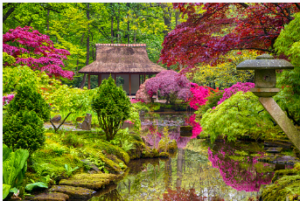Designing a garden is an intricate process that blends aesthetic and horticultural expertise with knowledge of the landscape and its purpose.
Designers employ principles of form, function, balance and symmetry to create a sense of place. The garden design SA structure is a three-dimensional consideration that considers the shape and volume of plants and other landscape features.
Sense of Place
 One of the essential elements in garden design is creating a sense of place. It can be accomplished through art, such as mirrors, terra-cotta pots, carpentry and ironwork that reflect natural elements found nearby, and sculptural pieces inspired by copper, limestone, local architecture and flowing water.
One of the essential elements in garden design is creating a sense of place. It can be accomplished through art, such as mirrors, terra-cotta pots, carpentry and ironwork that reflect natural elements found nearby, and sculptural pieces inspired by copper, limestone, local architecture and flowing water.
Many gardeners strive to create a sense of place in their spaces, yet this can be challenging due to the difficulty in getting plants to blend visually. To avoid this issue, selecting plants carefully is essential for successful results.
Landscape architects and designers should strive for the Gestalt amalgam – this holistic goal or objective that creates a sense of place in designed landscapes. The three essential components of this sense of place are significance, physical attributes and function as one cohesive whole.
It can be challenging to achieve this, but you will work towards it with the right landscape architect and designer. Ultimately, all three components must come together harmoniously for a sense of place to be created.
Form
The garden design SA uses form to describe the aesthetic qualities of an object that create a sense of space. It encompasses the overall outline of structures, plant beds, garden ornaments, and their three-dimensional mass.
In a formal garden, geometric shapes such as circles and squares may be mixed with polygonal forms that are more informal and naturalistic. The amount of negative space between objects further distinguishes shape and form.
Another factor that can influence garden form is colour. Modern gardens typically opt for a minimalist colour palette to achieve an even aesthetic.
Colour can draw attention, direct views, and emphasise certain features. For example, focal points – which draw the eye towards a specific place in the landscape – can be created with vibrant hues like yellow and red.
The line is essential in landscape design, conveying movement and widening the view. Curved lines can help shape informal garden beds and add interest to paths, while straight ones elicit a more formal air.
Vertical lines draw the eye upward, creating a sense of spaciousness and energy in any space. Walkways, hedges and short garden walls can all serve to develop vertical solid accents that connect areas while also creating visual separations.
Rhythm is the repetition of materials and elements such as mass, form, line, texture and colour. It can range from using the same hue or fabric in different places to more intricate structures like repeated patterns and motifs.
Function
The function is a design principle that must be considered when planning a garden. It means creating spaces with specific purposes in mind and considering all elements in their context relative to one another.
Lines are an integral element in function design, helping to guide the eye and create movement or a sense of rhythm. Lines can take shape from trees to fences or horizons and influence how people move through gardens.
Children’s function design can include areas for play, like a sandpit or swing. It may also feature areas where they can learn or practice their favourite sports like putting, tennis or basketball.
Plantings should serve a purpose beyond decoration in functional gardens, with exciting leaf shapes, colours and textures that provide visual interest all year long. Furthermore, plants should be hardy and tolerant of dry sun or wet shade conditions.
Designers face a formidable challenge when it comes to function when creating gardens. Mastering scale, proportion, balance, seasonality and horticulture requires someone with expert knowledge who can consider all elements holistically. Additionally, flexibility must be built-in so the garden can evolve as plants and materials mature and adapt. An experienced designer with knowledge of such matters can only acquire this knowledge.